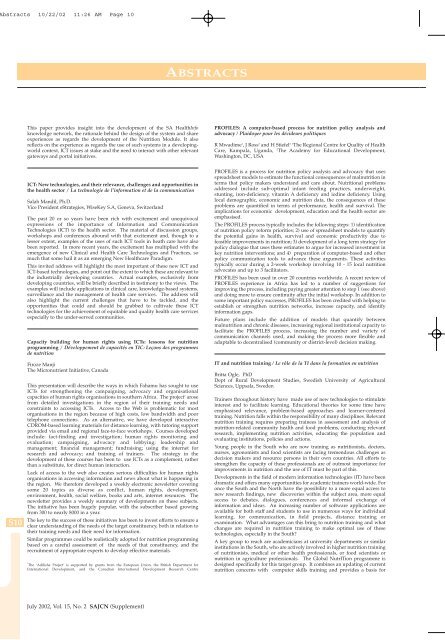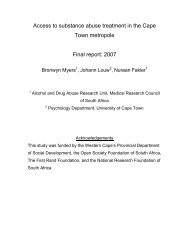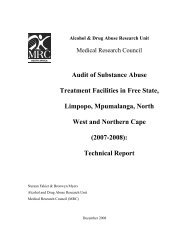Pan-African Conference 21 - 24 July 2002 Inter-Continental Hotel ...
Pan-African Conference 21 - 24 July 2002 Inter-Continental Hotel ...
Pan-African Conference 21 - 24 July 2002 Inter-Continental Hotel ...
Create successful ePaper yourself
Turn your PDF publications into a flip-book with our unique Google optimized e-Paper software.
Abstracts 10/22/02 11:26 AM Page 10<br />
S10<br />
This paper provides insight into the development of the SA HealthInfo<br />
knowledge network, the rationale behind the design of the system and share<br />
experiences as regards the development of the Nutrition Module. It also<br />
reflects on the experience as regards the use of such systems in a developingworld<br />
context, ICT issues at stake and the need to interact with other relevant<br />
gateways and portal initiatives.<br />
ICT: New technologies, and their relevance, challenges and opportunities in<br />
the health sector / La technologie de l’information et de la communication<br />
Salah Mandil, Ph.D.<br />
Vice President eStrategies, WiseKey S.A, Geneva, Switzerland<br />
The past 20 or so years have been rich with excitement and unequivocal<br />
expressions of the importance of Information and Communication<br />
Technologies (ICT) to the health sector. The material of discussion groups,<br />
workshops and conferences abound with that excitement and, though to a<br />
lesser extent, examples of the uses of such ICT tools in heath care have also<br />
been reported. In more recent years, the excitement has multiplied with the<br />
emergence of new Clinical and Health Care Technologies and Practices, so<br />
much that some hail it as an emerging New Healthcare Paradigm.<br />
This invited address will highlight the most important of these new ICT and<br />
ICT-based technologies, and point out the extent to which these are relevant to<br />
the industrially developing countries. Actual examples, exclusively from<br />
developing countries, will be briefly described in testimony to the views. The<br />
examples will include applications in clinical care, knowledge-based systems,<br />
surveillance and the management of health care services. The address will<br />
also highlight the current challenges that have to be tackled, and the<br />
opportunities that could and should be grabbed to cultivate these ICT<br />
technologies for the achievement of equitable and quality health care services<br />
especially to the under-served communities.<br />
Capacity building for human rights using ICTs: lessons for nutrition<br />
programming / Développement de capacités en TIC: Leçons des programmes<br />
de nutrition<br />
Firoze Manji<br />
The Micronutrient Initiative, Canada<br />
This presentation will describe the ways in which Fahamu has sought to use<br />
ICTs for strengthening the campaigning, advocacy and organisational<br />
capacities of human rights organisations in southern Africa. The project1 arose<br />
from detailed investigations in the region of their training needs and<br />
constraints to accessing ICTs. Access to the Web is problematic for most<br />
organisations in the region because of high costs, low bandwidth and poor<br />
telephone connections. As an alternative, we have developed interactive<br />
CDROM-based learning materials for distance learning, with tutoring support<br />
provided via email and regional face-to-face workshops. Courses developed<br />
include: fact-finding and investigation; human rights monitoring and<br />
evaluation; campaigning, advocacy and lobbying; leadership and<br />
management; financial management; fundraising; using the internet for<br />
research and advocacy; and training of trainers. The strategy in the<br />
development of these courses has been to use ICTs as a complement, rather<br />
than a substitute, for direct human interaction.<br />
Lack of access to the web also creates serious difficulties for human rights<br />
organisations in accessing information and news about what is happening in<br />
the region. We therefore developed a weekly electronic newsletter covering<br />
some 20 topics as diverse as conflict, human rights, development,<br />
environment, health, social welfare, books and arts, internet resources. The<br />
newsletter provides a weekly summary of developments on these subjects.<br />
The initiative has been hugely popular, with the subscriber based growing<br />
from 300 to nearly 8000 in a year.<br />
The key to the success of these initiatives has been to invest efforts to ensure a<br />
clear understanding of the needs of the target constituency, both in relation to<br />
their training needs and their need for information.<br />
Similar programmes could be realistically adopted for nutrition programming<br />
based on a careful assessment of the needs of that constituency, and the<br />
recruitment of appropriate experts to develop effective materials.<br />
1<br />
The ‘Adilisha Project’ is supported by grants from the European Union, the British Department for<br />
<strong>Inter</strong>national Development, and the Canadian <strong>Inter</strong>national Development Research Centre<br />
<strong>July</strong> <strong>2002</strong>, Vol. 15, No. 2 SAJCN (Supplement)<br />
ABSTRACTS<br />
PROFILES: A computer-based process for nutrition policy analysis and<br />
advocacy / Plaidoyer pour les décideurs politiques<br />
R Mwadime 1 , J Ross 2 and H Stiefel 2 1 The Regional Centre for Quality of Health<br />
Care, Kampala, Uganda, 2 The Academy for Educational Development,<br />
Washington, DC, USA<br />
PROFILES is a process for nutrition policy analysis and advocacy that uses<br />
spreadsheet models to estimate the functional consequences of malnutrition in<br />
terms that policy makers understand and care about. Nutritional problems<br />
addressed include sub-optimal infant feeding practices, underweight,<br />
stunting, iron-deficiency, vitamin A deficiency and iodine deficiency. Using<br />
local demographic, economic and nutrition data, the consequences of these<br />
problems are quantified in terms of performance, health and survival. The<br />
implications for economic development, education and the health sector are<br />
emphasised.<br />
The PROFILES process typically includes the following steps: 1) identification<br />
of nutrition policy reform priorities; 2) use of spreadsheet models to quantify<br />
the potential gains in health, survival and economic productivity due to<br />
feasible improvements in nutrition; 3) development of a long term strategy for<br />
policy dialogue that uses these estimates to argue for increased investment in<br />
key nutrition interventions; and 4) preparation of computer-based and other<br />
policy communication tools to advance these arguments. These activities<br />
typically occur during a 2-week workshop involving 10 - 15 local nutrition<br />
advocates and up to 3 facilitators.<br />
PROFILES has been used in over 20 countries worldwide. A recent review of<br />
PROFILES experience in Africa has led to a number of suggestions for<br />
improving the process, including paying greater attention to step 1 (see above)<br />
and doing more to ensure continuity after the initial workshop. In addition to<br />
some important policy successes, PROFILES has been credited with helping to<br />
establish or strengthen nutrition networks, increase capacity, and identify<br />
information gaps.<br />
Future plans include the addition of models that quantify between<br />
malnutrition and chronic diseases, increasing regional institutional capacity to<br />
facilitate the PROFILES process, increasing the number and variety of<br />
communication channels used, and making the process more flexible and<br />
adaptable to decentralised (community or district-level) decision making.<br />
IT and nutrition training / Le rôle de la TI dans la formation en nutrition<br />
Britta Ogle, PhD<br />
Dept of Rural Development Studies, Swedish University of Agricultural<br />
Sciences, Uppsala, Sweden<br />
Trainers throughout history have made use of new technologies to stimulate<br />
interest and to facilitate learning. Educational theories for some time have<br />
emphasised relevance, problem-based approaches and learner-centered<br />
training. Nutrition falls within the responsibility of many disciplines. Relevant<br />
nutrition training requires preparing trainees in assessment and analysis of<br />
nutrition-related community health and food problems, conducting relevant<br />
research, implementing nutrition activities, educating the population and<br />
evaluating institutions, policies and actions.<br />
Young people in the South who are now training as nutritionists, doctors,<br />
nurses, agronomists and food scientists are facing tremendous challenges as<br />
decision makers and resource persons in their own countries. All efforts to<br />
strengthen the capacity of these professionals are of outmost importance for<br />
improvements in nutrition and the use of IT must be part of this.<br />
Developments in the field of modern information technologies (IT) have been<br />
dramatic and offers many opportunities for academic trainers world-wide. For<br />
once the South and the North have the possibility to a more equal access to<br />
new research findings, new discoveries within the subject area, more equal<br />
access to debates, dialogues, conferences and informal exchange of<br />
information and ideas. An increasing number of software applications are<br />
available for both staff and students to use in numerous ways for individual<br />
learning, for communication, in field projects, distance training or<br />
examination. What advantages can this bring to nutrition training and what<br />
changes are required in nutrition training to make optimal use of these<br />
technologies, especially in the South?<br />
A key group to reach are academicians at university departments or similar<br />
institutions in the South, who are actively involved in higher nutrition training<br />
of nutritionists, medical or other health professionals, or food scientists or<br />
nutrition in agriculture professionals. The Global NutrITion programme is<br />
designed specifically for this target group. It combines an updating of current<br />
nutrition concerns with computer skills training and provides a basis for

















